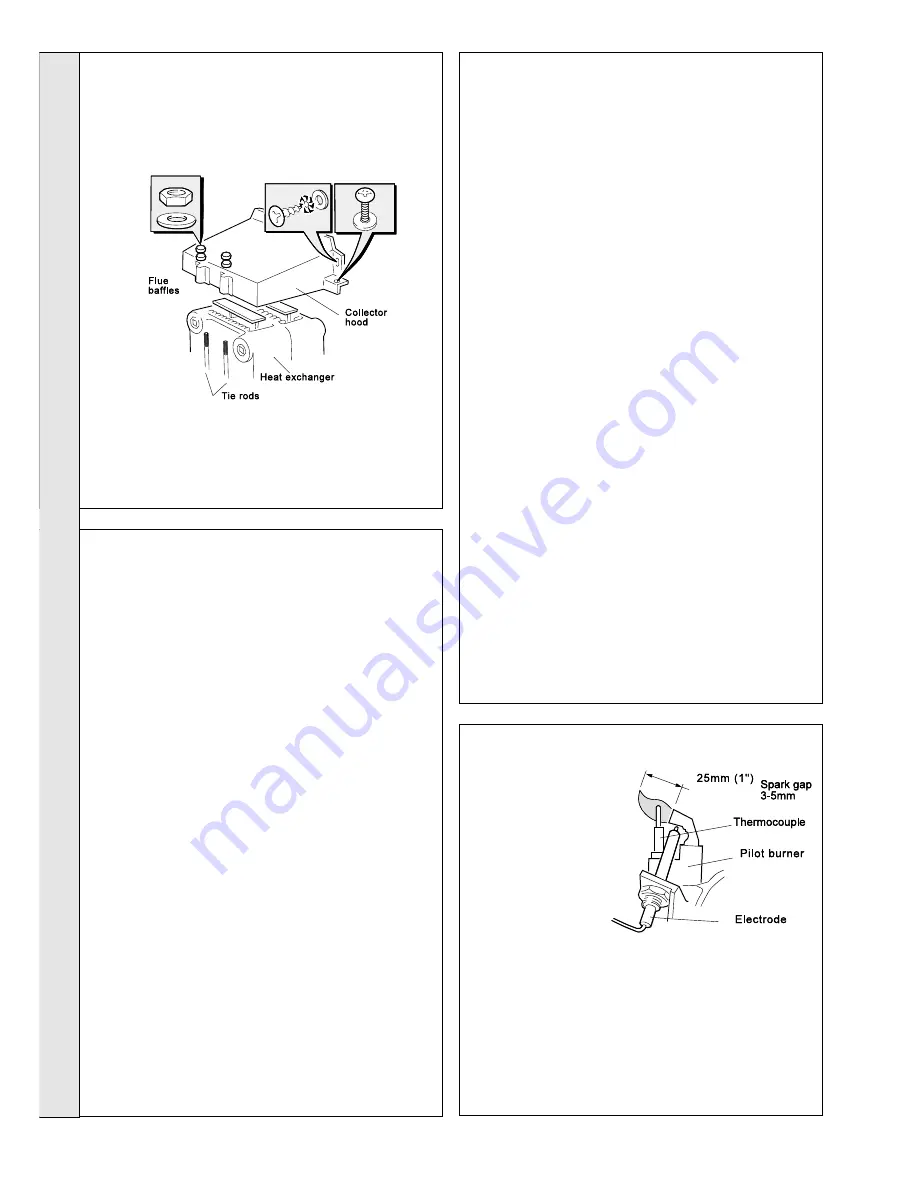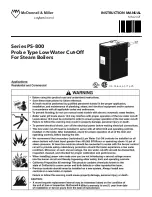
20
Classic LX, RS -
Installation
SERVICING
SER
VICING
1.
Turn on the gas
supply.
2.
Light the pilot (refer
to Frame 25) and
check that the pilot
flame envelopes the
tip of the
thermocouple and is
approximately 25
mm (1") long.
The pilot is factory
set to maximum and no further adjustment should be
necessary. However, if the pilot flame appears small,
check the pilot injector. Refer to Frame 39.
Heat Input / Setting Pressure
After each occasion of servicing, reference should be made
to Table 2, which quotes details of the rated output, with the
related burner setting pressure and the heat input. Any
required adjustment should be made by using the pressure
adjustment screw. Refer to Frame 25.
Re-assemble in reverse order to that shown in Frames 30
to 33.
1.
Refit the flue baffles and retain with the spring clips.
2.
Refit the collector hood, replacing any damaged or
deteriorating gaskets.
Note.
Ensure that the rear
vertical
hood retaining screws
are tightened BEFORE the rear
horizontal
screws and that
the tie rods are located into the holes in the base of the
combustion chamber .
3.
Refit the burner and air box assembly. Ensure the
burner tab is correctly located (refer to Frame 31).
4.
Refit the burner support.
5.
Refit the control box assembly.
6.
Turn on the gas supply.
7.
Ensure the sightglass in the boiler casing is clean and
undamaged .
8. Deluxe Model (LX)
- Refit the boiler casing. Tighten the
2 lower captive casing screws. Push the sliding catch in
and lower the glass fascia to the closed position.
Tighten the upper captive casing screw.
Standard Model
- Refit the boiler casing and tighten
the 3 captive screws. Close the pod door.
9.
Inspect the visible casing seal for correct fit.
10. Deluxe Model (LX)
- Push the sliding catch in and
lower the glass fascia to the closed position.
Standard Model -
Close the controls pod door.
34 RE-ASSEMBLY
33 CLEANING THE BURNER AND PILOT
ASSEMBLY
Refer to Frame 31 for illustration of the procedure below.
1.
Brush off any deposits that may have fallen onto the
burner head, ensuring the flame ports are unobstructed,
and remove any debris that may have collected.
Note.
Brushes with metallic bristles MUST NOT be used.
2.
The main burner injector can be removed, checked and
cleaned or replaced as required. Ensure an approved
jointing compound is used, sparingly.
3.
Inspect the pilot burner, thermocouple and spark
electrode; ensure they are clear and in good condition.
Check that:
a.
The pilot burner injector is not blocked or damaged
(refer to Frame 39 for removal details).
b.
The pilot burner is clean and unobstructed.
c.
The spark electrode is clean and undamaged.
d.
The spark lead is in good condition and securely
connected.
e.
The spark gap is correct. Refer Frame 35.
f.
The thermocouple tip is not burned or cracked.
g.
The position of the thermocouple relative to the pilot
burner is correct. Refer to Frame 35.
h.
The thermocouple terminal at the gas valve is clean.
4.
Re-assemble the burner / air box assembly in reverse
order. Ensure that the burner tab is correctly located.
Refer to Frame 31.
Note.
The pilot shield is positioned around the pilot
assembly bracket and is located by the electrode retaining
nut.
35 PILOT BURNER CHECKING
1.
Remove the collector hood by undoing the front tie rod
nuts and releasing the tie rods from the combustion
chamber. Withdraw the rods.
2.
Remove the 4 collector hood retaining screws and
washers.
32 CLEANING THE FLUEWAYS
3.
Uncouple and remove the flue baffles from the heat
exchanger.
Note.
There are no flue baffles in the RS 260.
4.
Remove all loose deposits from the heat exchanger,
particularly between the fins, using a suitable brush.
Summary of Contents for Classic LX RS 230
Page 1: ......













































